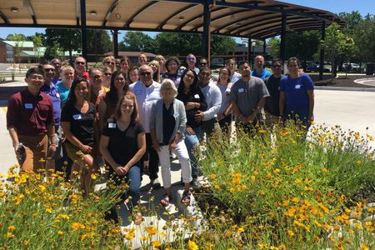Community-Led Initiative Aims To Enhance Equity In Grand Rapids Watershed Resilience
By U.S. EPA

Resilience can have many meanings, but for the communities facing increasing impacts of climate change, resilience is a way of planning for a safer and more prosperous future. The Lower Grand River Organization of Watersheds (LGROW) has been an Urban Waters Federal Partnership (UWFP) location since 2011. As part of UWFP, LGROW works in Grand Rapids, Michigan, to understand, protect, and improve the natural resources of the Lower Grand River watershed for all to enjoy. The UWFP connects urban communities, particularly those that are overburdened or economically distressed, with their waterways. The partnership does this by improving coordination among federal agencies and collaborating with community-led revitalization efforts to improve our nation's water systems and promote their economic, environmental, and social benefits.
Recognizing the increase of climate change impacts, such as flooding and heat, across the watershed, LGROW began an effort to create a Watershed Resilience Action Plan that would provide recommendations to local governments and communities on actions to enhance resilience. LGROW recognized that they needed to increase engagement with historically underserved communities in the watershed and wanted to ensure the plan included equity recommendations. The impacts of climate change do not affect all people equally, so including these recommendations was critical to ensure people share the benefits of climate resilience efforts.
EPA researchers, in partnership with EPA's Urban Waters Federal Partnership Program, conducted research on ways to support communities in making equity central to their resilience planning. They focused on methods and tools for engaging community members in assessing vulnerabilities and action planning.
“Many Urban Waters Partnership locations provide a platform for multi-stakeholder planning and coordination on issues impacting urban watersheds. By working with EPA researchers, we were able to develop a tool with a clear approach for how to build equity into a climate resilience planning process,” Jeanine Finley, a program analyst with the Urban Waters Federal Partnership Program, said.
In June 2022, LGROW and EPA organized three day-long workshops with partner organizations in the Indian Mill and Mill Creeks, Plaster Creek, and Buck Creek sub-watersheds. These workshops gathered input on community concerns around resilience and actions that could improve resilience. The workshops used activities and materials from EPA’s Equitable Resilience Builder tool. The Equitable Resilience Builder is a tool to support community resilience planning. It provides resources, guides and activities for participatory activities such as storytelling, mapping, indicator assessment, and action planning. It follows guiding principles such as building community relationships and trust, using local data and knowledge, recognizing trauma, facilitating action, providing accessibility for under-resourced communities, adapting to different users, and planning contexts.
The community engagement and resilience planning efforts are featured in a StoryMap created by the Urban Waters Learning Network, a nationwide peer-to-peer network of people and organizations working to conserve, restore and revitalize America’s urban waterways.
Workshop participants engaged in discussions highlighting hazards such as flooding, water quality, heat, and access to natural resources and the cascading impacts of these hazards, which often resulted in health issues. They emphasized prioritizing the needs of those most impacted, such as children, older adults, low-income households, and communities of color. Some specific actions included improving physical accessibility to natural areas, involving youth in active roles to enhance engagement and skills, leveraging trusted community information providers, mitigating extreme heat impacts, and directing resources to populations most affected by hazards and threats.
For LGROW, the workshops were a chance to engage more deeply with communities and better understand resilience and equity, which helped improve the Watershed Resilience Plan.
“The Grand River/Grand Rapids Urban Waters Federal Partnership works to protect, restore, and revitalize urban water sources, while pursing environmental justice in the Lower Grand River Watershed,” Robert Cloy II, an Urban Waters Ambassador to the Grand Valley Metro Council, said. “Engaging with community members throughout the watershed strengthens community resiliency helps create a vision that the waterways belong to everyone.”
For EPA, the workshops and the partnership with LGROW provided critical input for research and development efforts around supporting equitable resilience planning in communities. Lessons learned about engaging community members, equity principles, workshop facilitation, and more helped develop the Equitable Resilience Builder.
"These workshops led by LGROW, the Grand River/Grand Rapids Urban Waters Federal Partnership and EPA showcase the power of collaboration between local communities and federal agencies in fostering resilient and equitable communities," EPA researcher Emily Eisenhauer said. Eisenhauer was one of the team members who developed the Equitable Resilience Builder and assisted with the workshops. "We hope to continue these kinds of partnerships where we can strengthen all of our capacity for creating safe and healthy communities.”
Learn More about the Science:
